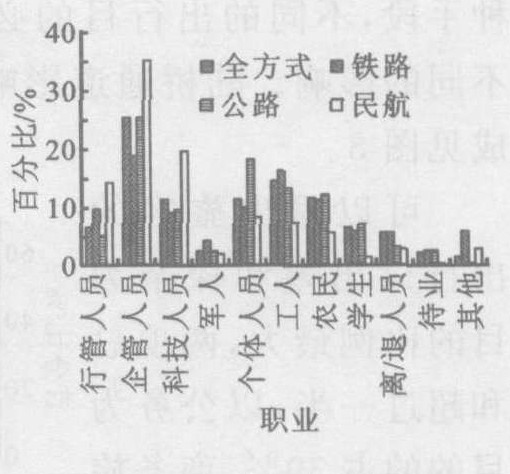Travel choice characteristics of transportation corridor of Europe-Asia
-
摘要: 为预测综合运输通道客运需求结构变化, 以陆桥运输通道为例, 对不同运输方式旅客出行调查数据进行了统计分析。旅客的职业分布中企管人员占20%以上, 其余主要是工人、农民和个体经商人员; 月收入1 000元以下者主要选择公路, 2 000元以上者选择民航比例较高, 中等收入者多选择铁路; 以出差和探亲为目的出行者占50%以上; 出行距离分布分析显示, 公路优势在200km以内, 民航优势在1 500 km以上, 铁路以中长距离为主; 旅客对服务属性选择, 以安全为第一要素者近60%, 其次才是速度和费用。结果表明, 随着各种运输方式的不断建设和发展, 陆桥通道内部客运市场正逐步扩大, 表现出较强的多样性和不均衡性。Abstract: In order to estimate the travelers demand construction of comprehensive transportation corridor, the travelers structure of Europe-Asia transportation corridor(EATC) in China was investigated. 20% of the whole travelers are administers, most of other travelers are workers, peasants and businessmen. The income of highway travelers is below 1 000 Yuan, and the income of airline travelers is more than 2 000 Yuan. More than half of the whole travelers are businessment and visitors. Travelers will choose highway travel if the travel distance is within 200 km, and will choose plane travel if the travel distance is further than 1 500 km. Nearly 60% of the whole travelers would like to choose safety transport modes. Analyzing results indicate that the transport market will be expanded, the demands of travelers will be more diverse than ever with the development of the various transport modes.
-
表 1 第一重要服务属性比例
Table 1. Preference service attribution ration
方式 第一重要服务属性比例/% 安全 费用 舒适 速度 直达 全方式 58.17 7.76 10.35 18.51 5.21 铁路 58.17 15.96 7.71 13.76 4.40 公路 58.64 5.83 10.07 18.77 6.69 民航 51.64 2.13 6.56 35.69 3.98 表 2 最不满意服务属性排序
Table 2. Worst service attribution ration
/% 运输方式 票价高 不舒服 不方便 不安全 速度慢 不准时 铁路 38.26 7.69 3.10 2.03 37.87 11.05 公路 29.16 21.30 2.58 14.90 27.93 4.13 民航 65.28 10.60 5.37 14.60 1.56 2.59 表 3 旅客最愿意选择的旅行方式
Table 3. Optimum selection travel modes
/% 旅客类型 最愿意选择的旅行方式 公路 铁路 民航 普通 高速 全方式旅客 25.13 15.37 56.39 3.11 铁路旅客 14.52 12.52 60.07 12.89 公路旅客 49.56 12.04 36.22 2.18 民航旅客 1.36 1.68 41.78 55.18 -
[1] 许庆斌, 荣朝和, 马远. 运输经济学导论[M]. 北京: 中国铁道出版社, 1995. [2] 王炜, 过秀成. 交通工程学[M]. 南京: 东南大学出版社, 2000. [3] 严宝杰. 交通调查与分析[M]. 北京: 人民交通出版社, 1994. [4] 彭辉, 陈宽民. 郑西客运专线旅客问卷调查及分析报告[R]. 西安: 长安大学, 2003. [5] 沈志云. 交通运输工程学[M]. 北京: 人民交通出版社, 2001. [6] 汪春华, 王元庆, 周伟. 西江运输通道对产业带的促进作用[J]. 中国公路学报, 2000, 13(2): 102-104. https://www.cnki.com.cn/Article/CJFDTOTAL-ZGGL200002025.htmWANG Chun-hua, WANG Yuan-qing, ZHOU Wei. Study of Xijing transportation corridor and related industrial cincture [J]. China Journal of Highway and Transport, 2000, 13(2): 102-104. (in Chinese) https://www.cnki.com.cn/Article/CJFDTOTAL-ZGGL200002025.htm [7] 张周堂. 旅客运输体系的演变分析[J]. 交通运输工程学报, 2004, 4(3): 85-89. http://transport.chd.edu.cn/article/id/200403020ZHANG Zhou-tang. Development of passenger transport system[J]. Journal of Traffic and Transportation Engineering, 2004, 4(3): 85-89. (in Chinese) http://transport.chd.edu.cn/article/id/200403020 -





 下载:
下载:






